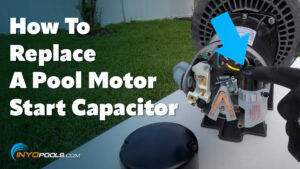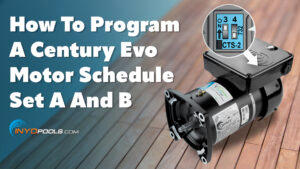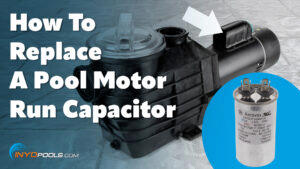Hello and welcome to Poolside Repair. We’re in lovely Orlando, Florida. Matt and Rob are helping out Dennis who wants to install a new Century V-Green with V-Link control on his daughter’s pool.She currently has a single speed motor that’s not cost-efficient. By upgrading to a V-green motor we hope to cut utility cost by at least 50%. The V-Link control and app allows you to track your pump motor’s power consumption, so you can see the savings in real-time.
The Install
Disassembling the pump
We will start with disassembling the old pump to remove the old motor and see what others of the pump we need to replace.
That just pops right off, put this to the side, take the wheel ring. Okay, so the next step would be to remove the impeller, but before you do that, you’ve got to stabilize the shaft, otherwise, it’s going to keep spinning. We’re going to use a 7/16 wrench, slide in here behind the protector. We’re going to stabilize and, basically, you just turn the impeller so that it locks in place like that. And then we’ll spin the impeller off counterclockwise. The seal plate will just pop right off. No critters running out, so that’s good. All right. So we’re going to go ahead and take the bolts out here to get the motor plate.
Again, we’re using a 9/6 inch socket. So we got the bolt out, so we just going to take the motor, play it off, and it’s that simple. All right. So we got the two motors side by side, obviously, this is the old one, is the new, the V-Green. It’s the 1.65. You can see the interface here. The 2.7 has the digital interface.
All the V-Green motors are totally enclosed and fan-cooled, making it last longer than your standard single or dual speed motor.
At this point, we’re going to start to put on some of the old parts back on the new motor, minus the shaft seal. Every time you replace a motor the shaft seal should be replaced along with it. Reusing old shaft seals leads to a leaky seam that will lead water directly to your brand new electric motor. Improper shaft seal installation and its physical effects on the motor is a leading cause voided warranties. So make sure, you find the correct shaft seal or gasket kit.
How to Program The Century V-Green
We’re going to move into programming the motor. The motor comes with a factory preset but, obviously, we want to do our own schedule. The way we’re going to do that is we’re going to press step one. On this side, you can see that it says “duration” over these numbers, and that’s how many hours it’s going to run for. Let’s say we’re going to run it for four hours. You’re going to press step one. Then it’s going to take it over to speed. You can see the RPM readings over there. Let’s have it at 3100. To save that, you would just go to step two, and let’s say step one. We’re going to do the same thing for all of these.
Then once you have step three, the next button push that you do is going to save step three. You don’t have to worry about that. Let’s say you want to do an override.
If you want to, for whatever reason, you want to press override and have it run for, let’s say two hours, and then you’re going to have it run at 3450, which is full-bore, and that will do the full power of the motor. That’s just in case, let’s say, you want to run the cleaner. If you have a suction side cleaner or something like that, it gives you a chance to run the motor, to mess with any of the step; one, two, or three.
We’ve got the VGreen installed. Next thing we’re going to install the century VLink, the wireless motor interface. We’re just going to unbox to take a look at it. Basically, it comes with everything. You’ll need to install it minus the tools. Let’s take a look here. You got your user manual, you got the actual VLink, and then you have all the other cables and the connectors that you’ll need.
Yes. We were looking at the app, and before, it was costing anywhere, depending on the time of year, $50-70 to run the single speed pump per month. The app is already telling us, this is December, but it’s going to be running $10 a month right now. You might be looking at $20 a month in summer, but that’s still a heck of a lot of savings.













Leave a Reply